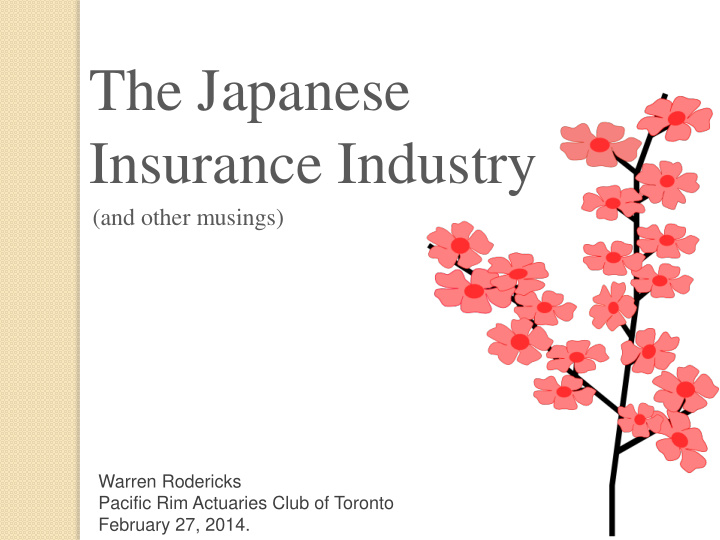



The Japanese Insurance Industry (and other musings) Warren Rodericks Pacific Rim Actuaries Club of Toronto February 27, 2014.
Natural Disasters
Q: What was Japan’s deadliest natural disaster? A) 2011 Tohoku Earthquake and Tsunami B) 1995 Kobe Earthquake C) 1923 Kantou Earthquake D) 1792 Mount Uzen Eruption
Many disasters to choose from! Volcanoes Typhoons Earthquakes Tsunamis Pandemic
Uncertainty Avoidance
Cultural Dimensions Theory Gerard Hendrik Hofstede’s four cultural dimensions framework Formulated in 1980 while working for IBM Describes “Uncertainty Avoidance” as the extent to which members of a society attempt to cope with anxiety by minimizing uncertainty.
Q: Which country has the highest Uncertainty Avoidance score? A) Greece B) Japan C) Argentina D) Germany
100 120 20 40 60 80 0 Argentina Australia Austria Canada Belgium Brazil Canada Uncertainty Avoidance Rank Chile Colombia Costa Rica Denmark Ecuador Finland France Germany (F.R.) Great Britain Greece Guatemala Hong Kong India Indonesia Iran Ireland Israel Italy Jamaica Japan Korea (S.) Malaysia Mexico Netherlands New Zealand Japan Norway Pakistan Panama Peru Philippines Portugal Salvadore Singapore South Africa Spain Sweden Switzerland Taiwan Thailand Turkey United States Uruguay Venezuela Yugoslavia
Uncertainty Avoidance Earthquake early warning system Highly efficient transit Household savings held in cash Bunting in baseball Well-developed insurance market
Japanese Insurance Market
2012 Premium Volume Belgium 1% Ireland Sweden 1% 1% United States South Africa 28% 1% Rest of the world 11% Switzerland 1% India 1% Spain 2% Brazil 2% Australia 2% Taiwan 2% Netherlands 2% Canada 3% South Korea 3% Italy 3% Japan United PR France 14% Germany Kingdom China 5% 5% 7% 5% Source: 2012 Swiss Re Sigma World Insurance Report
2012 Insurance Penetration (%) 20 18 16 14 12 10 8 6 4 2 0 Taiwan South Africa Netherlands Hong Kong South Korea Japan United Kingdom Finland Switzerland Denmark Source: 2012 Swiss Re Sigma World Insurance Report
2012 Insurance Density (USD) 8000 7000 6000 5000 4000 3000 2000 1000 0 Switzerland Netherlands Denmark Japan Luxembourg Finland Hong Kong Norway United Kingdom United States Source: 2012 Swiss Re Sigma World Insurance Report
Q: What percentage of Japanese households had life insurance in 2012? A) 95% B) 85% C) 75% D) 65%
2012 Life Insurance Ownership (%) 100% 95% 90% 85% 80% 75% 70% 65% 60% Source: 2013 LIAJ Report on Life Insurance Business in Japan
2012 Insurance Company Assets (Millions USD) 1,200,000 1,000,000 800,000 600,000 400,000 200,000 -
2012 Insurance Company Premiums (Millions USD) 90,000 80,000 70,000 60,000 50,000 40,000 30,000 20,000 10,000 -
Classifications of Insurance • Life Insurance, Annuity Products First Sector • Business restricted to Life Insurance Companies • Auto, Property, Fire Insurance etc. Second Sector • Business restricted to P&C Insurance Companies • Medical, LTC insurance Third Sector • Both Life and P&C companies may sell
First Sector Product Types Individual Annuity Individual Insurance Other 10% Endowment Variable 9% 16% Whole Life 35% Term 11% Cancer Fixed Insurance Medical 84% 15% Life 20% Source: 2013 LIAJ Report on Life Insurance Business in Japan
Japanese Economy
Q: What is Japan’s biggest export? A) Consumer Electronics B) Motor Vehicles C) Baseball Players D) Robots
Postwar Period (1950’s - 1970’s) Heavy Industrialization Infrastructure Growth Liberalization of Trade Transition to Export Economy Democratization Emergence of the Keiretsu
Keiretsu Group of companies with interlocking dependent business relationships and ownership A bank is central to the structure
Bubble Economy (1980’s) Asset prices skyrocketed Increased money supply Borrowing and speculation Delayed reaction by BOJ
Lost Decade(s) (1990’s onwards) Gradual collapse of asset price bubbles and negative growth Bank and insurance failures Revision of finance law Growing Government debt Sustained decline in interest rates
10 12 0 2 4 6 8 1974 Source: Japan Ministry of Finance JGB 5yr Historical Rates (%) 1975 1976 1977 Post-War 1978 1979 1980 1981 1982 1983 1984 1985 1986 Bubble 1987 1988 1989 1990 1991 1992 1993 1994 1995 1996 1997 Lost Decade(s) 1998 1999 2000 2001 2002 2003 2004 2005 2006 2007 2008 2009 2010 2011 2012 2013
Low Interest Rate Environment Two decades of declining interest rates Poor equity returns during the same period Life market dominated by long-term products with high guaranteed returns Under-developed ALM (asset duration too short) Led to the “negative spread” problem and structural changes in the industry
1996 Standard Valuation Law New reserve regime required NLP reserves Discount rates based on 10yr JGB rates Guaranteed rates peaked around 6% while discount rates now 2.75% caused increased reserves Resulted in guaranteed rates coming down to currently less than 2% Introduction of cash flow testing
Improved ALM Increase in asset duration Increase in domestic fixed income, especially JGBs Improved internal modeling/stress testing
Market Trends Move to shorter term products Focus on mortality and morbidity margins, especially 3 rd sector Growth in variable annuities Foreign return-linked products Expansion outside of Japan
Working in Japan
Q: What is the meaning of the word “Sumimasen”? A) “Excuse me!” B) “Yes Please!” C) “I’m Sorry!” D) “Thank You!” E) All of the Above!
Unique Work Culture Communication barriers (High/Low context) Decision by Consensus Harmony (Never say “no”) Relationship building Group dynamic
終
Recommend
More recommend